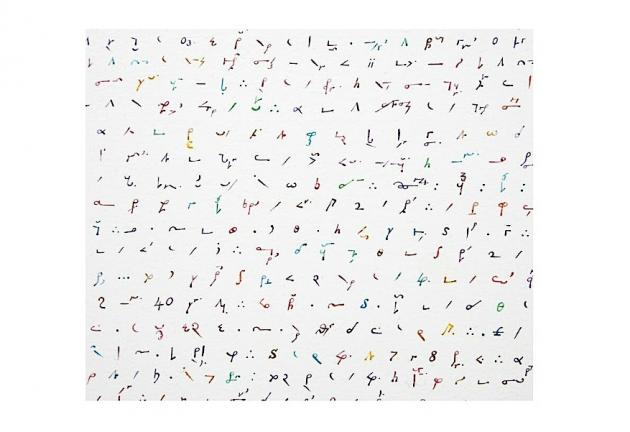For his first exhibition of new work since 2008, Simon Lewty presents a remarkable group of drawings in which compelling new developments are immediately evident. His chance discovery of Thomas Shelton’s 17thC system of shorthand, ‘Tachygraphy’, provided him with a written surface after his own heart that was beautiful, but opaque to all guesses as to its meaning. What a surprise it is to learn that in fact Samuel Pepys used this very system in his famous diary of 1660 – 69 to convey with relish and great verve, an image of the turbulent Baroque age in which he lived.
Lewty taught himself the now obscure system over several years, and has incorporated its conceptual clarity into his own works. Radiant coloured inks both reflect its mysterious appeal and bring something of Pepys’s energy to the freshly choreographed calligraphy of Lewty’s own surfaces.
“The word tachygraphy seemed in a crazy way to invite a link with the Tachisme of our own time: the two words share a root”, observes Lewty. “Shelton and Pepys meet Hartung and Michaux! Art and literature…”
Lewty’s writing stems from his dream journals and a plethora of notebooks. The narratives, sometimes epic, sometimes conversational, range from a declamatory voice to more recent fragments of human dialogue captured from train journeys, and other contemporary sources. His scripts are all woven into what he describes as ‘a calligraphic skin’, as echoes of inscribed speech.
Smaller, most recent drawings in the show remind us that Lewty’s practice covers many forms of script, from the familiar longhand of personal journals, narrative fragments and lists, to the ceremonial dignity of inked ‘italic’ columns or blocks with their strictly justified margins. Text with a Moth reveals that he has even practiced writing in the ‘italic’ typeface of his Adler typewriter which itself mimics the handwritten, but bestows on it a neutral tone.
Early Songs, The Real Within the Voice, Notations From a Script for a Phonetic Play, Pyrographic Script… these titles in the exhibition suggest music and drama or perhaps a short story. Archaic or Post Modern, their resonance is timeless. Yet they are also timely at the present ‘digital’ moment, when, as Philip Henscher has recently lamented, the practice of handwriting (and typewriting) may become things of the recent past. But handwriting has never been simply a utilitarian means to an end. Released into the limitless spaces of the body and the sign, Simon Lewty’s calligraphies are both meditations and performances, surfaces of mystery, devotion and energy. They invite us to an unforgettable journey of discovery; they offer the joys of a unique revelation.

